Transfer Learning for Time Series Forecasting with Darts#
Authors: Julien Herzen, Florian Ravasi, Guillaume Raille, Gaël Grosch.
Overview#
The goal of this notebook is to explore transfer learning for time series forecasting – that is, training forecasting models on one time series dataset and using it on another. The notebook is 100% self-contained – i.e., it also contains the necessary commands to install dependencies and download the datasets being used.
Depending on what constitutes a “learning task”, what we call transfer learning here can also be seen under the angle of meta-learning (or “learning to learn”), where models can adapt themselves to new tasks (e.g. forecasting a new time series) at inference time without further training [1].
This notebook is an adaptation of a workshop on “Forecasting and Meta-Learning” that was given at the Applied Machine Learning Days conference in Lausanne, Switzerland, in March 2022. It contains the following parts:
Part 0: Initial setup - imports, functions to download data, etc.
Part 1: Forecasting passenger counts series for 300 airlines (
airdataset). We will train one model per series.Part 2: Using “global” models - i.e., models trained on all 300 series simultaneously.
Part 3: We will try some transfer learning, and see what happens if we train some global models on one (big) dataset (
m4dataset) and use them on another dataset.Part 4: We will reuse our pre-trained model(s) of Part 3 on another new dataset (
m3dataset) and see how it compares to models specifically trained on this dataset.
The compute durations written for the different models have been obtained by running the notebook on a Apple Silicon M2 CPU, with Python 3.10.13 and Darts 0.27.0.
Part 0: Setup#
First, we need to have the right libraries and make the right imports. For the deep learning models, it helps to have a GPU, but this is not mandatory.
The following two cells need to be run only once. They install the dependencies and download all the required datasets.
[ ]:
%%bash
pip install xlrd
pip install darts
[2]:
%%bash
# Execute this cell once to download all three datasets
curl -L https://forecasters.org/data/m3comp/M3C.xls -o m3_dataset.xls
curl -L https://data.transportation.gov/api/views/xgub-n9bw/rows.csv -o carrier_passengers.csv
curl -L https://raw.githubusercontent.com/Mcompetitions/M4-methods/master/Dataset/Train/Monthly-train.csv \
-o m4_monthly.csv
curl -L https://raw.githubusercontent.com/Mcompetitions/M4-methods/master/Dataset/M4-info.csv -o m4_metadata.csv
% Total % Received % Xferd Average Speed Time Time Time Current
Dload Upload Total Spent Left Speed
100 1716k 100 1716k 0 0 6899k 0 --:--:-- --:--:-- --:--:-- 6949k
% Total % Received % Xferd Average Speed Time Time Time Current
Dload Upload Total Spent Left Speed
100 56.3M 0 56.3M 0 0 1747k 0 --:--:-- 0:00:33 --:--:-- 2142k
% Total % Received % Xferd Average Speed Time Time Time Current
Dload Upload Total Spent Left Speed
100 87.4M 100 87.4M 0 0 26.2M 0 0:00:03 0:00:03 --:--:-- 26.3M
% Total % Received % Xferd Average Speed Time Time Time Current
Dload Upload Total Spent Left Speed
100 4233k 100 4233k 0 0 5150k 0 --:--:-- --:--:-- --:--:-- 5163k 0 0 --:--:-- --:--:-- --:--:-- 0
And now we import everything. Don’t be afraid, we will uncover what these imports mean through the notebook :)
[ ]:
%matplotlib inline
import warnings
warnings.filterwarnings("ignore")
import random
import time
from datetime import datetime
from itertools import product
from typing import Optional
import matplotlib.pyplot as plt
import numpy as np
import pandas as pd
import torch
from sklearn.preprocessing import MaxAbsScaler
from tqdm.auto import tqdm
from darts import TimeSeries
from darts.dataprocessing.transformers import Scaler
from darts.metrics import smape
from darts.models import (
ARIMA,
ExponentialSmoothing,
KalmanForecaster,
LightGBMModel,
LinearRegressionModel,
NaiveSeasonal,
NBEATSModel,
RandomForestModel,
Theta,
)
from darts.utils.losses import SmapeLoss
We define the forecast horizon here - for all of the (monthly) time series used in this notebook, we’ll be interested in forecasting 18 months in advance. We pick 18 months as this is what is used in the M3/M4 competitions for monthly series.
[4]:
HORIZON = 18
Datasets loading methods#
Here, we define some helper methods to load the three datasets we’ll be playing with: air, m3 and m4.
All the methods below return two list of TimeSeries: one list of training series and one list of “test” series (of length HORIZON).
For convenience, all the series are already scaled here, by multiplying each of them by a constant so that the largest value is 1. Such scaling is necessary for many models to work correctly (esp. deep learning models). It does not affect the sMAPE values, so we can evaluate the accuracy of our algorithms on the scaled series. In a real application, we would have to keep the Darts Scaler objects somewhere in order to inverse-scale the forecasts.
If you are interested in seeing an example of how creating and scaling TimeSeries is done, you can inspect the function load_m3().
[5]:
def load_m3() -> tuple[list[TimeSeries], list[TimeSeries]]:
print("building M3 TimeSeries...")
# Read DataFrame
df_m3 = pd.read_excel("m3_dataset.xls", "M3Month")
# Build TimeSeries
m3_series = []
for row in tqdm(df_m3.iterrows()):
s = row[1]
start_year = int(s["Starting Year"])
start_month = int(s["Starting Month"])
values_series = s[6:].dropna()
if start_month == 0:
continue
start_date = datetime(year=start_year, month=start_month, day=1)
time_axis = pd.date_range(start_date, periods=len(values_series), freq="M")
series = TimeSeries.from_times_and_values(
time_axis, values_series.values
).astype(np.float32)
m3_series.append(series)
print(f"\nThere are {len(m3_series)} monthly series in the M3 dataset")
# Split train/test
print("splitting train/test...")
m3_train = [s[:-HORIZON] for s in m3_series]
m3_test = [s[-HORIZON:] for s in m3_series]
# Scale so that the largest value is 1
print("scaling...")
scaler_m3 = Scaler(scaler=MaxAbsScaler())
m3_train_scaled: list[TimeSeries] = scaler_m3.fit_transform(m3_train)
m3_test_scaled: list[TimeSeries] = scaler_m3.transform(m3_test)
print(
f"done. There are {len(m3_train_scaled)} series, with average training length {np.mean([len(s) for s in m3_train_scaled])}" # noqa: E501
)
return m3_train_scaled, m3_test_scaled
def load_air() -> tuple[list[TimeSeries], list[TimeSeries]]:
# download csv file
df = pd.read_csv("carrier_passengers.csv")
# extract relevant columns
df = df[["data_dte", "carrier", "Total"]]
# aggregate per carrier and date
df = pd.DataFrame(df.groupby(["carrier", "data_dte"]).sum())
# move indexes to columns
df = df.reset_index()
# group bt carrier, specify time index and target variable
all_air_series = TimeSeries.from_group_dataframe(
df, group_cols="carrier", time_col="data_dte", value_cols="Total", freq="MS"
)
# Split train/test
print("splitting train/test...")
air_train = []
air_test = []
for series in all_air_series:
# remove the end of the series
series = series[: pd.Timestamp("2019-12-31")]
# convert to proper type
series = series.astype(np.float32)
# extract longest contiguous slice
try:
series = series.longest_contiguous_slice()
except Exception:
continue
# remove static covariates
series = series.with_static_covariates(None)
# remove short series
if len(series) >= 36 + HORIZON:
air_train.append(series[:-HORIZON])
air_test.append(series[-HORIZON:])
# Scale so that the largest value is 1
print("scaling series...")
scaler_air = Scaler(scaler=MaxAbsScaler())
air_train_scaled: list[TimeSeries] = scaler_air.fit_transform(air_train)
air_test_scaled: list[TimeSeries] = scaler_air.transform(air_test)
print(
f"done. There are {len(air_train_scaled)} series, with average training length {np.mean([len(s) for s in air_train_scaled])}" # noqa: E501
)
return air_train_scaled, air_test_scaled
def load_m4(
max_number_series: Optional[int] = None,
) -> tuple[list[TimeSeries], list[TimeSeries]]:
"""
Due to the size of the dataset, this function takes approximately 10 minutes.
Use the `max_number_series` parameter to reduce the computation time if necessary
"""
# Read data dataFrame
df_m4 = pd.read_csv("m4_monthly.csv")
if max_number_series is not None:
df_m4 = df_m4[:max_number_series]
# Read metadata dataframe
df_meta = pd.read_csv("m4_metadata.csv")
df_meta = df_meta.loc[df_meta.SP == "Monthly"]
# Build TimeSeries
m4_train = []
m4_test = []
for row in tqdm(df_m4.iterrows(), total=len(df_m4)):
s = row[1]
values_series = s[1:].dropna()
start_date = pd.Timestamp(
df_meta.loc[df_meta["M4id"] == "M1", "StartingDate"].values[0]
)
time_axis = pd.date_range(start_date, periods=len(values_series), freq="M")
series = TimeSeries.from_times_and_values(
time_axis, values_series.values
).astype(np.float32)
# remove series with less than 48 training samples
if len(series) > 48 + HORIZON:
# Split train/test
m4_train.append(series[:-HORIZON])
m4_test.append(series[-HORIZON:])
print(f"\nThere are {len(m4_train)} monthly series in the M3 dataset")
# Scale so that the largest value is 1
print("scaling...")
scaler_m4 = Scaler(scaler=MaxAbsScaler())
m4_train_scaled: list[TimeSeries] = scaler_m4.fit_transform(m4_train)
m4_test_scaled: list[TimeSeries] = scaler_m4.transform(m4_test)
print(
f"done. There are {len(m4_train_scaled)} series, with average training length {np.mean([len(s) for s in m4_train_scaled])}" # noqa: E501
)
return m4_train_scaled, m4_test_scaled
Finally, we define a handy function to tell us how good a bunch of forecasted series are:
[6]:
def eval_forecasts(
pred_series: list[TimeSeries], test_series: list[TimeSeries]
) -> list[float]:
print("computing sMAPEs...")
smapes = smape(test_series, pred_series)
plt.figure()
plt.hist(smapes, bins=50)
plt.ylabel("Count")
plt.xlabel("sMAPE")
plt.title(f"Median sMAPE: {np.median(smapes):.3f}")
plt.show()
plt.close()
return smapes
Part 1: Local models on the air dataset#
Inspecting Data#
The air dataset contains the number of air passengers that flew in or out of the USA per carrier (or airline company) from the year 2000 until 2019.
First, we can load the train and test series by calling load_air() function that we have defined above.
[7]:
air_train, air_test = load_air()
IndexError: The type of your index was not matched.
splitting train/test...
IndexError: The type of your index was not matched.
IndexError: The type of your index was not matched.
IndexError: The type of your index was not matched.
IndexError: The type of your index was not matched.
IndexError: The type of your index was not matched.
IndexError: The type of your index was not matched.
IndexError: The type of your index was not matched.
IndexError: The type of your index was not matched.
IndexError: The type of your index was not matched.
IndexError: The type of your index was not matched.
IndexError: The type of your index was not matched.
IndexError: The type of your index was not matched.
IndexError: The type of your index was not matched.
scaling series...
done. There are 245 series, with average training length 154.06938775510204
It’s a good idea to start by visualising a few of the series to get a sense of what they look like. We can plot a series by calling series.plot().
[8]:
figure, ax = plt.subplots(3, 2, figsize=(10, 10), dpi=100)
for i, idx in enumerate([1, 20, 50, 100, 150, 200]):
axis = ax[i % 3, i % 2]
air_train[idx].plot(ax=axis)
axis.legend(air_train[idx].components)
axis.set_title("")
plt.tight_layout()
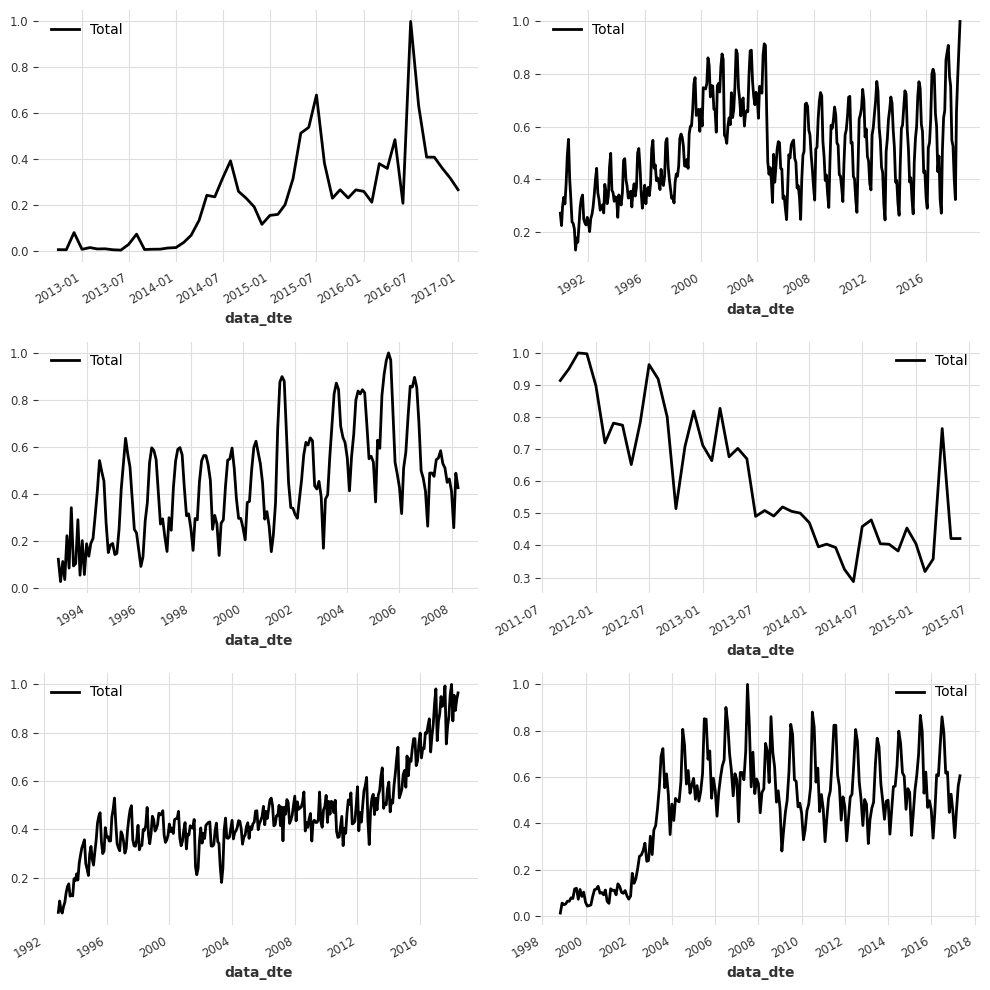
We can see that most series look quite different, and they even have different time axes! For example some series start in Jan 2001 and others in April 2010.
Let’s see what is the shortest train series available:
[9]:
min([len(s) for s in air_train])
[9]:
36
A useful function to evaluate models#
Below, we write a small function that will make our life easier for quickly trying and comparing different local models. We loop through each serie, fit a model and then evaluate on our test dataset.
⚠️
tqdmis optional and is only there to help display the training progress (as you will see it can take some time when training 300+ time series)
[10]:
def eval_local_model(
train_series: list[TimeSeries], test_series: list[TimeSeries], model_cls, **kwargs
) -> tuple[list[float], float]:
preds = []
start_time = time.time()
for series in tqdm(train_series):
model = model_cls(**kwargs)
model.fit(series)
pred = model.predict(n=HORIZON)
preds.append(pred)
elapsed_time = time.time() - start_time
smapes = eval_forecasts(preds, test_series)
return smapes, elapsed_time
Building and evaluating models#
We can now try a first forecasting model on this dataset. As a first step, it is usually a good practice to see how a (very) naive model blindly repeating the last value of the training series performs. This can be done in Darts using a NaiveSeasonal model:
[11]:
naive1_smapes, naive1_time = eval_local_model(air_train, air_test, NaiveSeasonal, K=1)
computing sMAPEs...
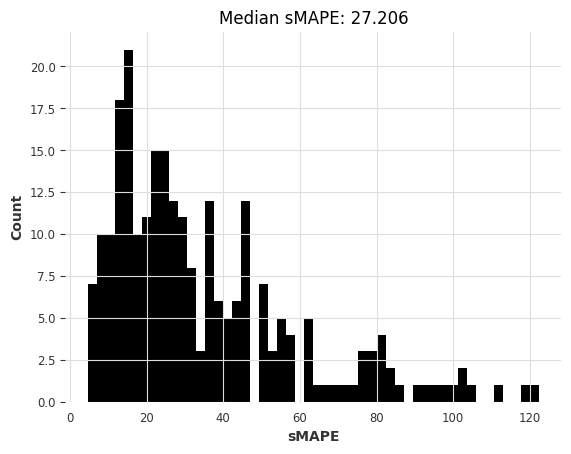
So the most naive model gives us a median sMAPE of about 27.2.
Can we do better with a “less naive” model exploiting the fact that most monthly series have a seasonality of 12?
[12]:
naive12_smapes, naive12_time = eval_local_model(
air_train, air_test, NaiveSeasonal, K=12
)
computing sMAPEs...
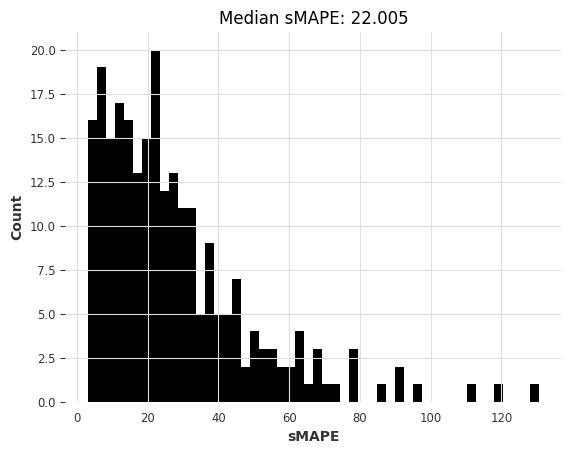
This is better. Let’s try ExponentialSmoothing (by default, for monthly series, it will use a seasonality of 12):
[13]:
ets_smapes, ets_time = eval_local_model(air_train, air_test, ExponentialSmoothing)
computing sMAPEs...
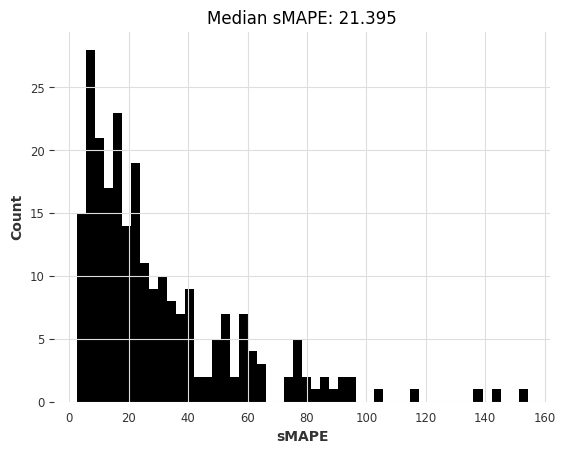
The median is slightly better than the naive seasonal model. Another model that we can quickly is the Theta method which has won the M3 competition:
[14]:
theta_smapes, theta_time = eval_local_model(air_train, air_test, Theta, theta=1.5)
computing sMAPEs...
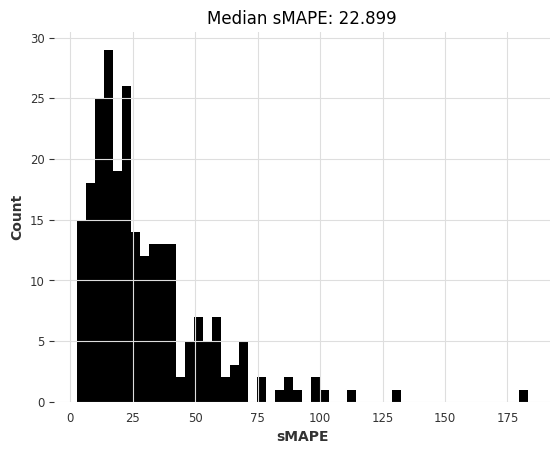
And how about ARIMA?
[15]:
warnings.filterwarnings("ignore") # ARIMA generates lots of warnings
arima_smapes, arima_time = eval_local_model(air_train, air_test, ARIMA, p=12, d=1, q=1)
computing sMAPEs...
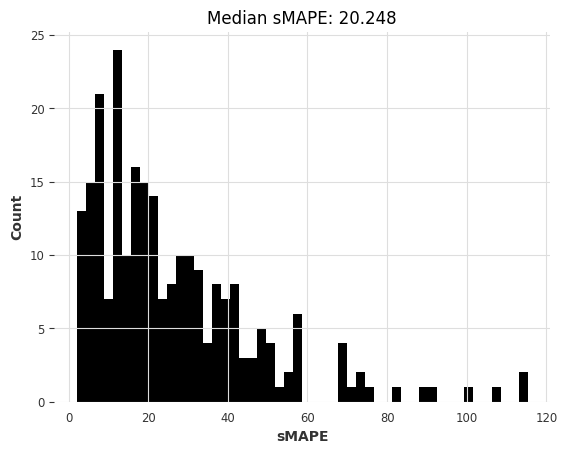
Or the Kalman Filter? (in Darts, fitting Kalman filters uses the N4SID system identification algorithm)
[16]:
kf_smapes, kf_time = eval_local_model(air_train, air_test, KalmanForecaster, dim_x=12)
computing sMAPEs...
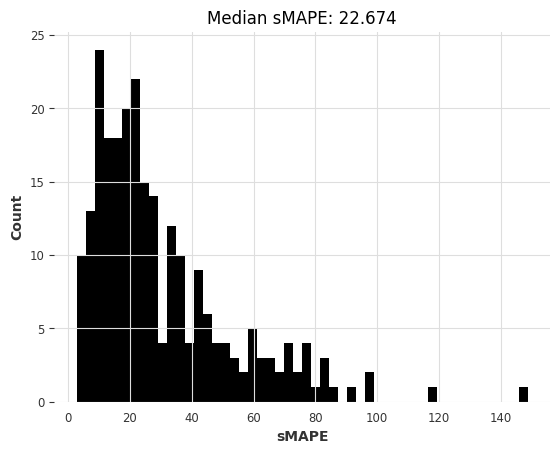
Comparing models#
Below, we define a function that will be useful to visualise how models compare to each other in terms of median sMAPE, and time required to obtain the forecasts.
[17]:
def plot_models(method_to_elapsed_times, method_to_smapes):
shapes = ["o", "s", "*"]
colors = ["tab:blue", "tab:orange", "tab:green", "tab:red", "tab:purple"]
styles = list(product(shapes, colors))
plt.figure(figsize=(6, 6), dpi=100)
for i, method in enumerate(method_to_elapsed_times.keys()):
t = method_to_elapsed_times[method]
s = styles[i]
plt.semilogx(
[t],
[np.median(method_to_smapes[method])],
s[0],
color=s[1],
label=method,
markersize=13,
)
plt.xlabel("elapsed time [s]")
plt.ylabel("median sMAPE over all series")
plt.legend(bbox_to_anchor=(1.4, 1.0), frameon=True)
[18]:
smapes = {
"naive-last": naive1_smapes,
"naive-seasonal": naive12_smapes,
"Exponential Smoothing": ets_smapes,
"Theta": theta_smapes,
"ARIMA": arima_smapes,
"Kalman Filter": kf_smapes,
}
elapsed_times = {
"naive-last": naive1_time,
"naive-seasonal": naive12_time,
"Exponential Smoothing": ets_time,
"Theta": theta_time,
"ARIMA": arima_time,
"Kalman Filter": kf_time,
}
plot_models(elapsed_times, smapes)
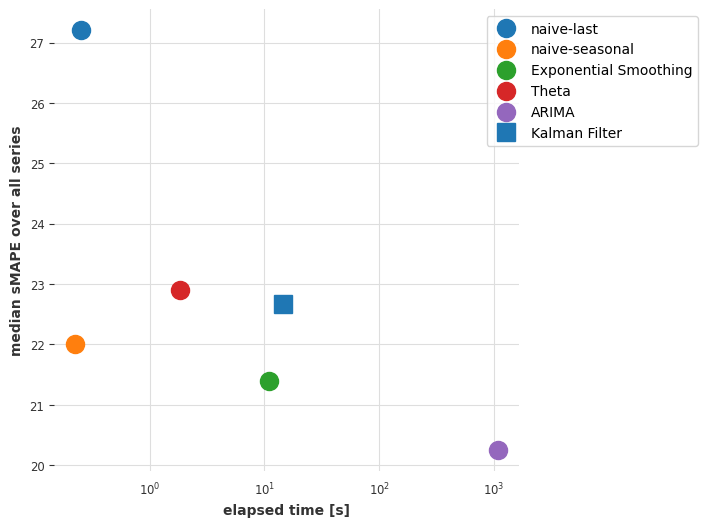
Conclusions so far#
ARIMA gives the best results, but it is also (by far) the most time-consuming model. The Exponential Smoothing model provides an interesting tradeoff, with good forecasting accuracy and lower computational cost. Can we maybe find a better compromise by considering global models - i.e., models that are trained only once, jointly on all time series?
Part 2: Global models on the air dataset#
In this section we will use “global models” - that is, models that are fit on multiple series at once. Darts has essentially two kinds of global models:
SKLearnModelswhich are wrappers around sklearn-like regression models (Part 2.1).PyTorch-based models, which offer various deep learning models (Part 2.2).
Both models can be trained on multiple series by “tabularizing” the data - i.e., taking many (input, output) sub-slices from all the training series, and training machine learning models in a supervised fashion to predict the output based on the input.
We start by defining a function eval_global_model() which works similarly to eval_local_model(), but on global models.
[19]:
def eval_global_model(
train_series: list[TimeSeries], test_series: list[TimeSeries], model_cls, **kwargs
) -> tuple[list[float], float]:
start_time = time.time()
model = model_cls(**kwargs)
model.fit(train_series)
preds = model.predict(n=HORIZON, series=train_series)
elapsed_time = time.time() - start_time
smapes = eval_forecasts(preds, test_series)
return smapes, elapsed_time
Part 2.1: Using Darts SKLearnModels.#
SKLearnModel in Darts are forecasting models that can wrap around any “scikit-learn compatible” regression model to obtain forecasts. Compared to deep learning, they represent good “go-to” global models because they typically don’t have many hyper-parameters and can be faster to train. In addition, Darts also offers some “pre-packaged” regression models such as LinearRegressionModel and LightGBMModel.
We’ll now use our function eval_global_models(). In the following cells, we will try using some regression models, for example:
LinearRegressionModelLightGBMModelSKLearnModel(some_sklearn_model)
You can refer to the API doc for how to use them.
Important parameters are lags and output_chunk_length. They determine respectively the length of the lookback and “lookforward” windows used by the model, and they correspond to the lengths of the input/output subslices used for training. For instance lags=24 and output_chunk_length=12 mean that the model will consume the past 24 lags in order to predict the next 12. In our case, because the shortest training series has length 36, we must have
lags + output_chunk_length <= 36. (Note that lags can also be a list of integers representing the individual lags to be consumed by the model instead of the window length).
[20]:
lr_smapes, lr_time = eval_global_model(
air_train, air_test, LinearRegressionModel, lags=30, output_chunk_length=1
)
computing sMAPEs...
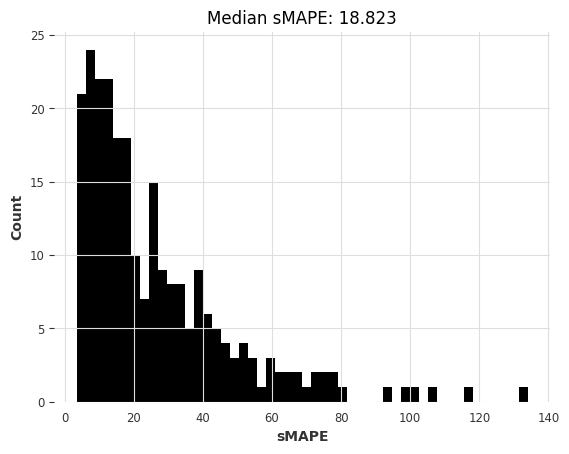
[21]:
lgbm_smapes, lgbm_time = eval_global_model(
air_train, air_test, LightGBMModel, lags=30, output_chunk_length=1, objective="mape"
)
[LightGBM] [Warning] Some label values are < 1 in absolute value. MAPE is unstable with such values, so LightGBM rounds them to 1.0 when calculating MAPE.
[LightGBM] [Info] Auto-choosing col-wise multi-threading, the overhead of testing was 0.003476 seconds.
You can set `force_col_wise=true` to remove the overhead.
[LightGBM] [Info] Total Bins 7649
[LightGBM] [Info] Number of data points in the train set: 30397, number of used features: 30
[LightGBM] [Info] Start training from score 0.481005
computing sMAPEs...
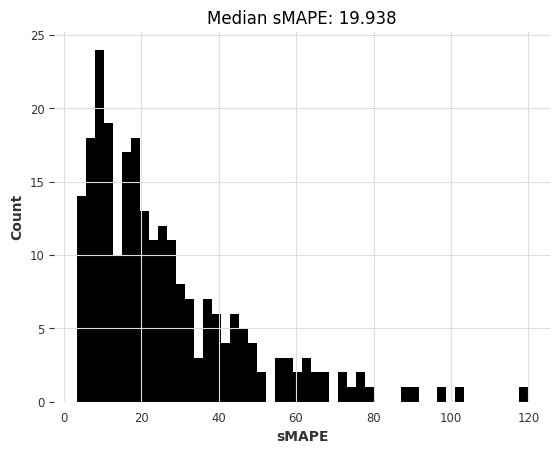
[ ]:
rf_smapes, rf_time = eval_global_model(
air_train, air_test, RandomForestModel, lags=30, output_chunk_length=1
)
computing sMAPEs...
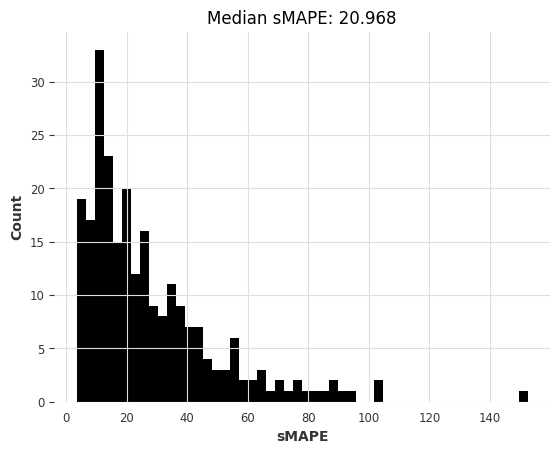
Part 2.2: Using deep learning#
Below, we will train an N-BEATS model on our air dataset. Again, you can refer to the API doc for documentation on the hyper-parameters. The following hyper-parameters should be a good starting point, and training should take in the order of a minute or two if you’re using a (somewhat slow) Colab GPU.
During training, you can have a look at the N-BEATS paper.
[23]:
### Possible N-BEATS hyper-parameters
# Slicing hyper-params:
IN_LEN = 30
OUT_LEN = 4
# Architecture hyper-params:
NUM_STACKS = 20
NUM_BLOCKS = 1
NUM_LAYERS = 2
LAYER_WIDTH = 136
COEFFS_DIM = 11
# Training settings:
LR = 1e-3
BATCH_SIZE = 1024
MAX_SAMPLES_PER_TS = 10
NUM_EPOCHS = 10
Let’s now build, train and predict using an N-BEATS model:
[24]:
# reproducibility
np.random.seed(42)
torch.manual_seed(42)
start_time = time.time()
nbeats_model_air = NBEATSModel(
input_chunk_length=IN_LEN,
output_chunk_length=OUT_LEN,
num_stacks=NUM_STACKS,
num_blocks=NUM_BLOCKS,
num_layers=NUM_LAYERS,
layer_widths=LAYER_WIDTH,
expansion_coefficient_dim=COEFFS_DIM,
loss_fn=SmapeLoss(),
batch_size=BATCH_SIZE,
optimizer_kwargs={"lr": LR},
pl_trainer_kwargs={
"enable_progress_bar": True,
# change this one to "gpu" if your notebook does run in a GPU environment:
"accelerator": "cpu",
},
)
nbeats_model_air.fit(air_train, dataloader_kwargs={"num_workers": 4}, epochs=NUM_EPOCHS)
# get predictions
nb_preds = nbeats_model_air.predict(series=air_train, n=HORIZON)
nbeats_elapsed_time = time.time() - start_time
nbeats_smapes = eval_forecasts(nb_preds, air_test)
GPU available: True (mps), used: False
TPU available: False, using: 0 TPU cores
IPU available: False, using: 0 IPUs
HPU available: False, using: 0 HPUs
| Name | Type | Params
---------------------------------------------------
0 | criterion | SmapeLoss | 0
1 | train_metrics | MetricCollection | 0
2 | val_metrics | MetricCollection | 0
3 | stacks | ModuleList | 525 K
---------------------------------------------------
523 K Trainable params
1.9 K Non-trainable params
525 K Total params
2.102 Total estimated model params size (MB)
`Trainer.fit` stopped: `max_epochs=10` reached.
GPU available: True (mps), used: False
TPU available: False, using: 0 TPU cores
IPU available: False, using: 0 IPUs
HPU available: False, using: 0 HPUs
computing sMAPEs...
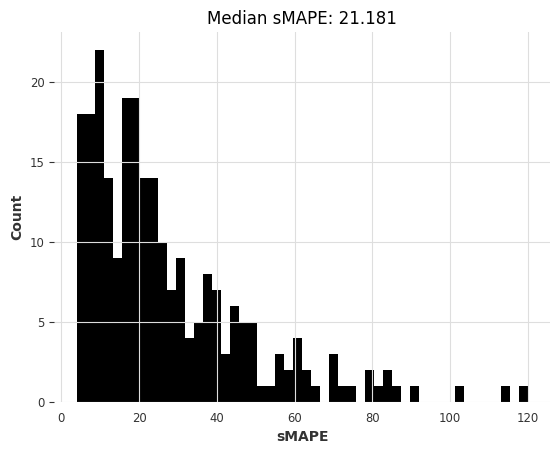
Let’s now look again at our errors -vs- time plot:
[25]:
smapes_2 = {
**smapes,
**{
"Linear Regression": lr_smapes,
"LGBM": lgbm_smapes,
"Random Forest": rf_smapes,
"NBeats": nbeats_smapes,
},
}
elapsed_times_2 = {
**elapsed_times,
**{
"Linear Regression": lr_time,
"LGBM": lgbm_time,
"Random Forest": rf_time,
"NBeats": nbeats_elapsed_time,
},
}
plot_models(elapsed_times_2, smapes_2)
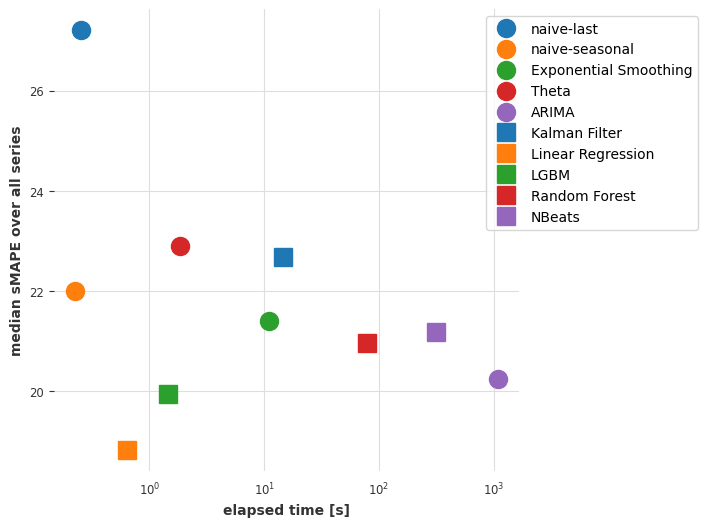
Conclusions so far#
So it looks like a linear regression model trained jointly on all series is now providing the best tradeoff between accuracy and speed. Linear regression is often the way to go!
Our deep learning model N-BEATS is not doing great. Note that we haven’t tried to tune it to this problem explicitly, doing so might have produced more accurate results. Instead of spending time tuning it though, in the next part we will see if it can do better by being trained on an entirely different dataset.
Part 3: Training an N-BEATS model on m4 dataset and use it to forecast air dataset#
Deep learning models often do better when trained on large datasets. Let’s try to load all 48,000 monthly time series in the M4 dataset and train our model once more on this larger dataset.
[26]:
m4_train, m4_test = load_m4()
There are 47087 monthly series in the M3 dataset
scaling...
done. There are 47087 series, with average training length 201.25202285131778
We can start from the same hyper-parameters as before.
With 48,000 M4 training series being on average ~200 time steps long, we would end up with ~10M training samples. With such a number of training samples, each epoch would take too long. So here, we’ll limit the number of training samples used per series. This is done when calling fit() with the parameter max_samples_per_ts. We add a new hyper-parameter MAX_SAMPLES_PER_TS to capture this.
Since the M4 training series are all slightly longer, we can also use a slightly longer input_chunk_length.
[27]:
# Slicing hyper-params:
IN_LEN = 36
OUT_LEN = 4
# Architecture hyper-params:
NUM_STACKS = 20
NUM_BLOCKS = 1
NUM_LAYERS = 2
LAYER_WIDTH = 136
COEFFS_DIM = 11
# Training settings:
LR = 1e-3
BATCH_SIZE = 1024
MAX_SAMPLES_PER_TS = (
10 # <-- new parameter, limiting the number of training samples per series
)
NUM_EPOCHS = 5
[28]:
# reproducibility
np.random.seed(42)
torch.manual_seed(42)
nbeats_model_m4 = NBEATSModel(
input_chunk_length=IN_LEN,
output_chunk_length=OUT_LEN,
batch_size=BATCH_SIZE,
num_stacks=NUM_STACKS,
num_blocks=NUM_BLOCKS,
num_layers=NUM_LAYERS,
layer_widths=LAYER_WIDTH,
expansion_coefficient_dim=COEFFS_DIM,
loss_fn=SmapeLoss(),
optimizer_kwargs={"lr": LR},
pl_trainer_kwargs={
"enable_progress_bar": True,
# change this one to "gpu" if your notebook does run in a GPU environment:
"accelerator": "cpu",
},
)
# Train
nbeats_model_m4.fit(
m4_train,
dataloader_kwargs={"num_workers": 4},
epochs=NUM_EPOCHS,
max_samples_per_ts=MAX_SAMPLES_PER_TS,
)
GPU available: True (mps), used: False
TPU available: False, using: 0 TPU cores
IPU available: False, using: 0 IPUs
HPU available: False, using: 0 HPUs
| Name | Type | Params
---------------------------------------------------
0 | criterion | SmapeLoss | 0
1 | train_metrics | MetricCollection | 0
2 | val_metrics | MetricCollection | 0
3 | stacks | ModuleList | 543 K
---------------------------------------------------
541 K Trainable params
1.9 K Non-trainable params
543 K Total params
2.173 Total estimated model params size (MB)
`Trainer.fit` stopped: `max_epochs=5` reached.
[28]:
NBEATSModel(generic_architecture=True, num_stacks=20, num_blocks=1, num_layers=2, layer_widths=136, expansion_coefficient_dim=11, trend_polynomial_degree=2, dropout=0.0, activation=ReLU, input_chunk_length=36, output_chunk_length=4, batch_size=1024, loss_fn=SmapeLoss(), optimizer_kwargs={'lr': 0.001}, pl_trainer_kwargs={'enable_progress_bar': True, 'accelerator': 'cpu'})
We can now use our M4-trained model to get forecasts for the air passengers series. As we use the model in a “meta learning” (or transfer learning) way here, we will be timing only the inference part.
[29]:
start_time = time.time()
preds = nbeats_model_m4.predict(series=air_train, n=HORIZON) # get forecasts
nbeats_m4_elapsed_time = time.time() - start_time
nbeats_m4_smapes = eval_forecasts(preds, air_test)
GPU available: True (mps), used: False
TPU available: False, using: 0 TPU cores
IPU available: False, using: 0 IPUs
HPU available: False, using: 0 HPUs
computing sMAPEs...
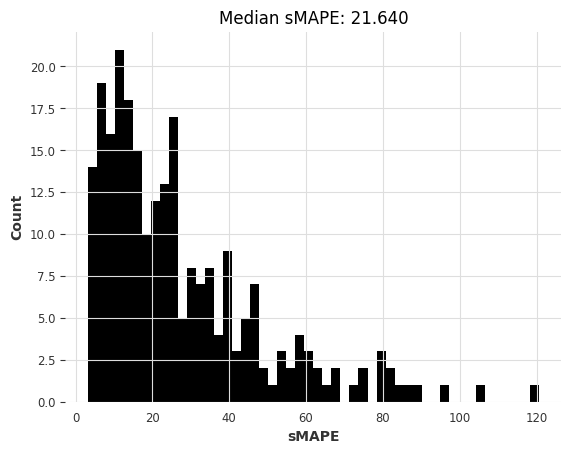
[30]:
smapes_3 = {**smapes_2, **{"N-BEATS (M4-trained)": nbeats_m4_smapes}}
elapsed_times_3 = {
**elapsed_times_2,
**{"N-BEATS (M4-trained)": nbeats_m4_elapsed_time},
}
plot_models(elapsed_times_3, smapes_3)
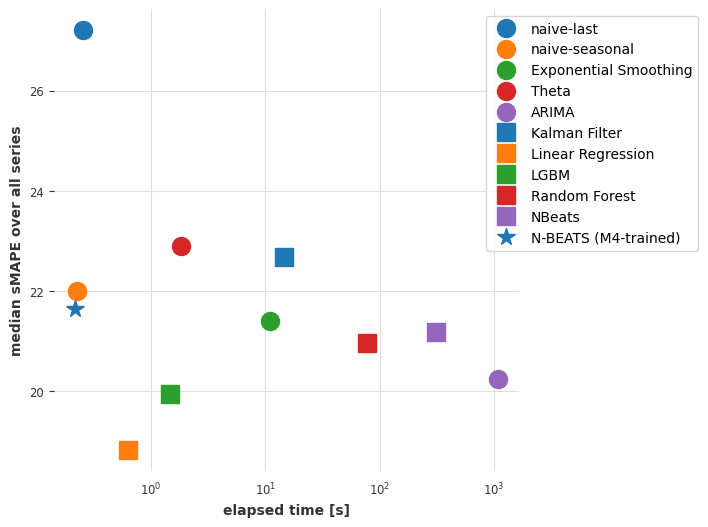
Conclusions so far#
Although it’s not the absolute best in terms of accuracy, our N-BEATS model trained on m4 reaches competitive accuracies. This is quite remarkable because this model has not been trained on any of the air series we’ve asked it to forecast! The forecasting step with N-BEATS is more than 1000x faster than the fit-predict step we needed with ARIMA, and also faster than with linear regression.
Just for the fun, we can also inspect manually how this model does on another series – for example, the monthly milk production series available in darts.datasets:
[31]:
from darts.datasets import MonthlyMilkDataset
series = MonthlyMilkDataset().load().astype(np.float32)
train, val = series[:-24], series[-24:]
scaler = Scaler(scaler=MaxAbsScaler())
train = scaler.fit_transform(train)
val = scaler.transform(val)
series = scaler.transform(series)
pred = nbeats_model_m4.predict(series=train, n=24)
series.plot(label="actual")
pred.plot(label="0-shot forecast")
GPU available: True (mps), used: False
TPU available: False, using: 0 TPU cores
IPU available: False, using: 0 IPUs
HPU available: False, using: 0 HPUs
[31]:
<Axes: xlabel='Month'>
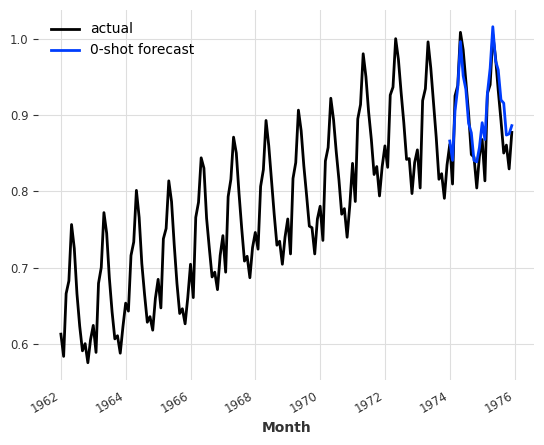
Try training other global models on m4 and applying on airline passengers#
Let’s now try to train other global models on the M4 dataset in order to see if we can get similar results. Below, we will train some SKLearnModels on the full m4 dataset. This can be quite slow. To have faster training we could use e.g., random.choices(m4_train, k=5000) instead of m4_train to limit the size of the training set. We could also specify some small enough value for max_samples_per_ts in order to limit the number of training samples.
[32]:
random.seed(42)
lr_model_m4 = LinearRegressionModel(lags=30, output_chunk_length=1)
lr_model_m4.fit(m4_train)
tic = time.time()
preds = lr_model_m4.predict(n=HORIZON, series=air_train)
lr_time_transfer = time.time() - tic
lr_smapes_transfer = eval_forecasts(preds, air_test)
computing sMAPEs...
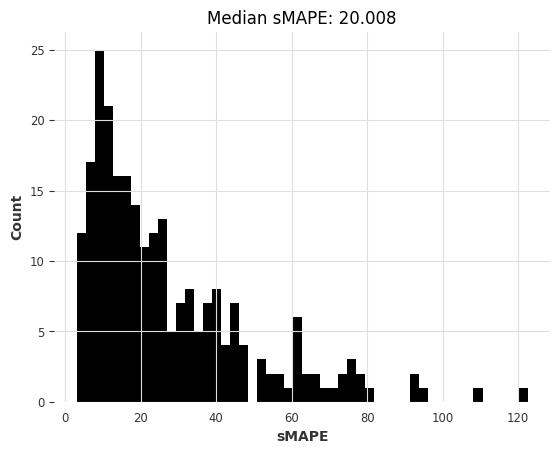
[33]:
random.seed(42)
lgbm_model_m4 = LightGBMModel(lags=30, output_chunk_length=1, objective="mape")
lgbm_model_m4.fit(m4_train)
tic = time.time()
preds = lgbm_model_m4.predict(n=HORIZON, series=air_train)
lgbm_time_transfer = time.time() - tic
lgbm_smapes_transfer = eval_forecasts(preds, air_test)
[LightGBM] [Warning] Some label values are < 1 in absolute value. MAPE is unstable with such values, so LightGBM rounds them to 1.0 when calculating MAPE.
[LightGBM] [Info] Auto-choosing row-wise multi-threading, the overhead of testing was 0.097573 seconds.
You can set `force_row_wise=true` to remove the overhead.
And if memory is not enough, you can set `force_col_wise=true`.
[LightGBM] [Info] Total Bins 7650
[LightGBM] [Info] Number of data points in the train set: 8063744, number of used features: 30
[LightGBM] [Info] Start training from score 0.722222
computing sMAPEs...
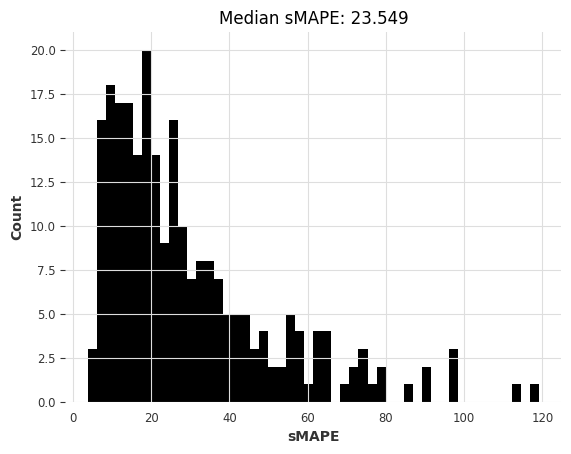
Finally, let’s plot these new results as well:
[34]:
smapes_4 = {
**smapes_3,
**{
"Linear Reg (M4-trained)": lr_smapes_transfer,
"LGBM (M4-trained)": lgbm_smapes_transfer,
},
}
elapsed_times_4 = {
**elapsed_times_3,
**{
"Linear Reg (M4-trained)": lr_time_transfer,
"LGBM (M4-trained)": lgbm_time_transfer,
},
}
plot_models(elapsed_times_4, smapes_4)
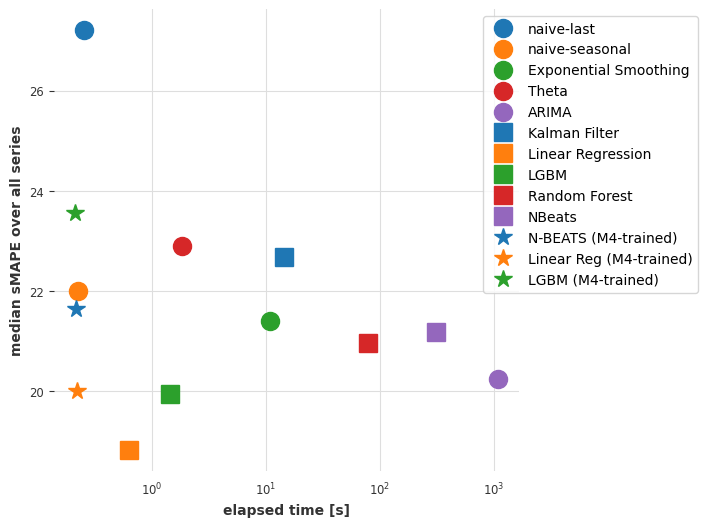
Part 4 and recap: Use the same model on M3 dataset#
OK, now, were we lucky with the airline passengers dataset? Let’s see by repeating the entire process on a new dataset :) You will see that it actually requires very few lines of code. As a new dataset, we will use m3, which contains about 1,400 monthly series from the M3 competition.
[35]:
m3_train, m3_test = load_m3()
building M3 TimeSeries...
There are 1399 monthly series in the M3 dataset
splitting train/test...
scaling...
done. There are 1399 series, with average training length 100.30092923516797
[36]:
naive1_smapes_m3, naive1_time_m3 = eval_local_model(
m3_train, m3_test, NaiveSeasonal, K=1
)
computing sMAPEs...
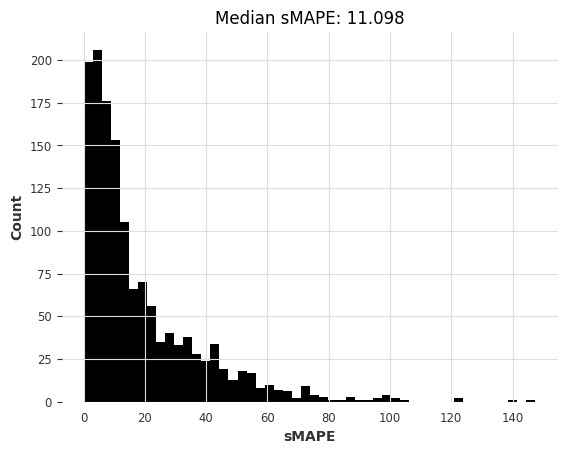
[37]:
naive12_smapes_m3, naive12_time_m3 = eval_local_model(
m3_train, m3_test, NaiveSeasonal, K=12
)
computing sMAPEs...
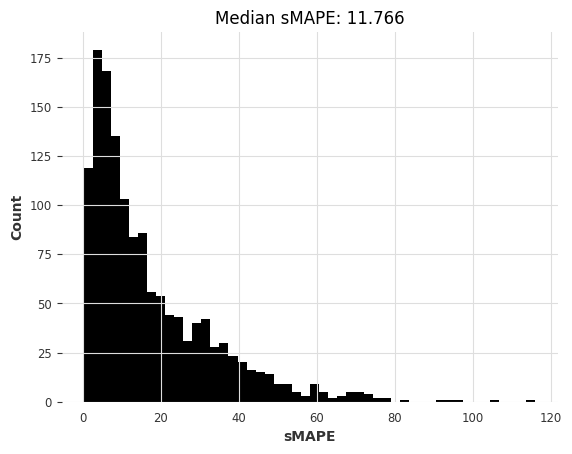
[38]:
ets_smapes_m3, ets_time_m3 = eval_local_model(m3_train, m3_test, ExponentialSmoothing)
computing sMAPEs...
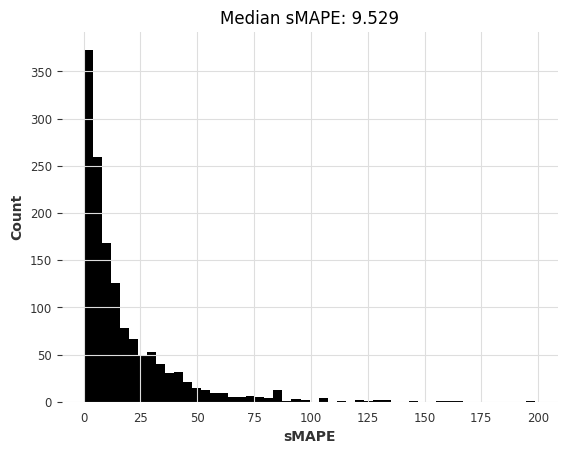
[39]:
theta_smapes_m3, theta_time_m3 = eval_local_model(m3_train, m3_test, Theta)
computing sMAPEs...

[40]:
warnings.filterwarnings("ignore") # ARIMA generates lots of warnings
# Note: using q=1 here generates errors for some series, so we use q=0
arima_smapes_m3, arima_time_m3 = eval_local_model(
m3_train, m3_test, ARIMA, p=12, d=1, q=0
)
computing sMAPEs...
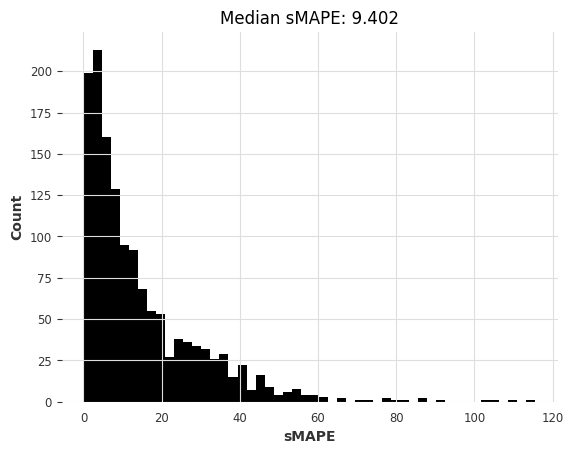
[41]:
kf_smapes_m3, kf_time_m3 = eval_local_model(
m3_train, m3_test, KalmanForecaster, dim_x=12
)
computing sMAPEs...
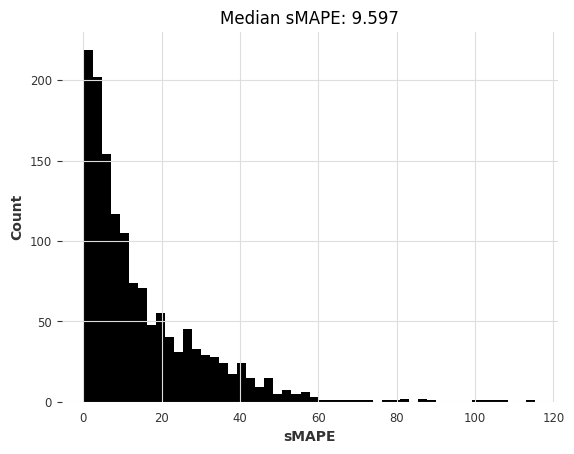
[42]:
lr_smapes_m3, lr_time_m3 = eval_global_model(
m3_train, m3_test, LinearRegressionModel, lags=30, output_chunk_length=1
)
computing sMAPEs...
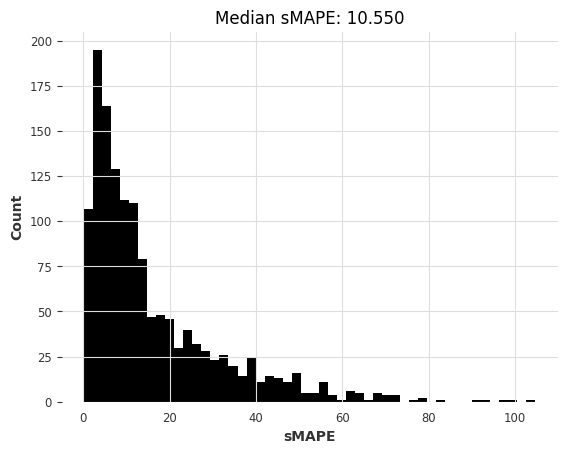
[43]:
lgbm_smapes_m3, lgbm_time_m3 = eval_global_model(
m3_train, m3_test, LightGBMModel, lags=35, output_chunk_length=1, objective="mape"
)
[LightGBM] [Warning] Some label values are < 1 in absolute value. MAPE is unstable with such values, so LightGBM rounds them to 1.0 when calculating MAPE.
[LightGBM] [Info] Auto-choosing col-wise multi-threading, the overhead of testing was 0.004819 seconds.
You can set `force_col_wise=true` to remove the overhead.
[LightGBM] [Info] Total Bins 8925
[LightGBM] [Info] Number of data points in the train set: 91356, number of used features: 35
[LightGBM] [Info] Start training from score 0.771293
computing sMAPEs...
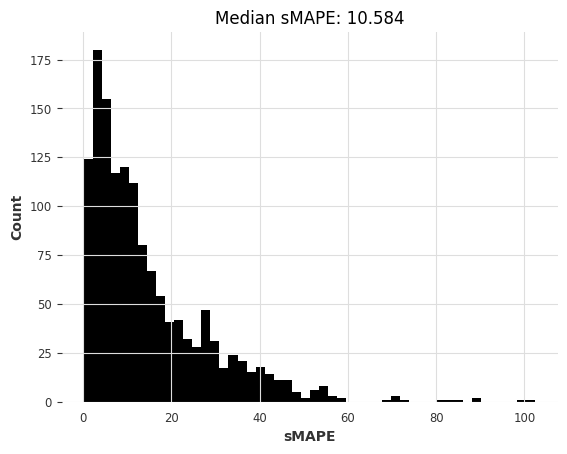
[44]:
# Get forecasts with our pre-trained N-BEATS
start_time = time.time()
preds = nbeats_model_m4.predict(series=m3_train, n=HORIZON) # get forecasts
nbeats_m4_elapsed_time_m3 = time.time() - start_time
nbeats_m4_smapes_m3 = eval_forecasts(preds, m3_test)
GPU available: True (mps), used: False
TPU available: False, using: 0 TPU cores
IPU available: False, using: 0 IPUs
HPU available: False, using: 0 HPUs
computing sMAPEs...
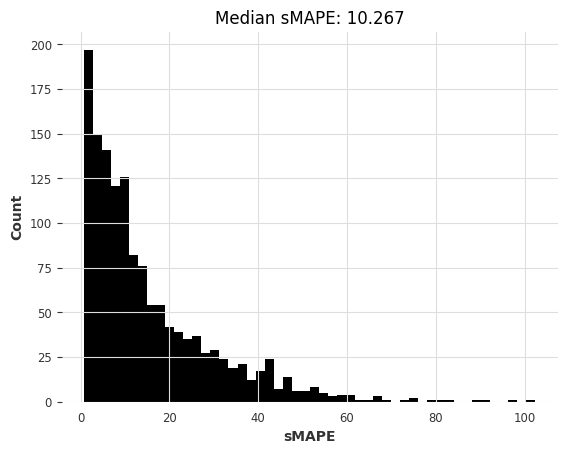
[45]:
# Get forecasts with our pre-trained linear regression model
start_time = time.time()
preds = lr_model_m4.predict(series=m3_train, n=HORIZON) # get forecasts
lr_m4_elapsed_time_m3 = time.time() - start_time
lr_m4_smapes_m3 = eval_forecasts(preds, m3_test)
computing sMAPEs...
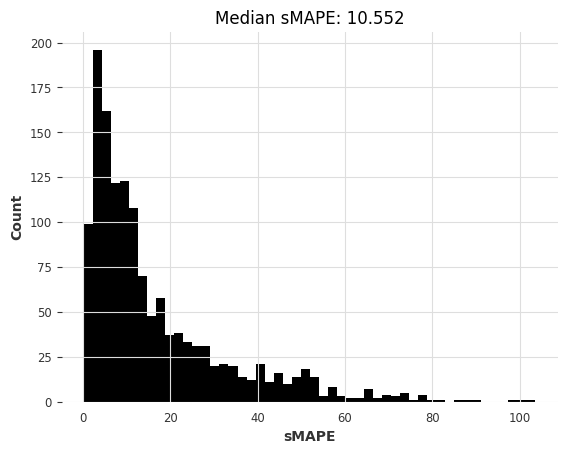
[46]:
# Get forecasts with our pre-trained LightGBM model
start_time = time.time()
preds = lgbm_model_m4.predict(series=m3_train, n=HORIZON) # get forecasts
lgbm_m4_elapsed_time_m3 = time.time() - start_time
lgbm_m4_smapes_m3 = eval_forecasts(preds, m3_test)
computing sMAPEs...
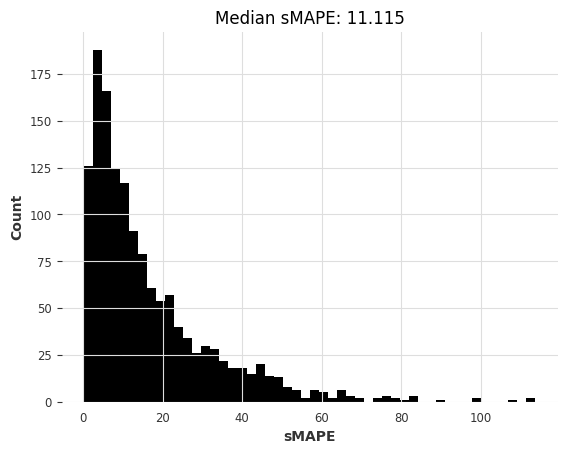
[47]:
smapes_m3 = {
"naive-last": naive1_smapes_m3,
"naive-seasonal": naive12_smapes_m3,
"Exponential Smoothing": ets_smapes_m3,
"ARIMA": arima_smapes_m3,
"Theta": theta_smapes_m3,
"Kalman filter": kf_smapes_m3,
"Linear Regression": lr_smapes_m3,
"LGBM": lgbm_smapes_m3,
"N-BEATS (M4-trained)": nbeats_m4_smapes_m3,
"Linear Reg (M4-trained)": lr_m4_smapes_m3,
"LGBM (M4-trained)": lgbm_m4_smapes_m3,
}
times_m3 = {
"naive-last": naive1_time_m3,
"naive-seasonal": naive12_time_m3,
"Exponential Smoothing": ets_time_m3,
"ARIMA": arima_time_m3,
"Theta": theta_time_m3,
"Kalman filter": kf_time_m3,
"Linear Regression": lr_time_m3,
"LGBM": lgbm_time_m3,
"N-BEATS (M4-trained)": nbeats_m4_elapsed_time_m3,
"Linear Reg (M4-trained)": lr_m4_elapsed_time_m3,
"LGBM (M4-trained)": lgbm_m4_elapsed_time_m3,
}
plot_models(times_m3, smapes_m3)
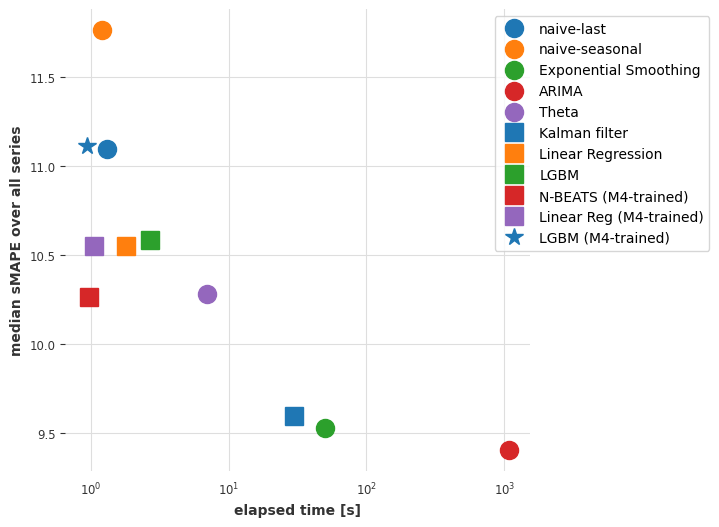
Here too, the pre-trained N-BEATS model obtains reasonable accuracy, although not as good as the most accurate models. Note also that Exponential Smoothing and Kalman Filter now perform much better than when we used them on the air passengers series. ARIMA performs best but is about 1000x slower than N-BEATS, which didn’t require any training and takes about 15 ms per time series to produce its forecasts. Recall that this N-BEATS model has never been trained on any of the series we’re asking it to forecast.
Conclusions#
Transfer learning and meta learning is definitely an interesting phenomenon that is at the moment under-explored in time series forecasting. When does it succeed? When does it fail? Can fine tuning help? When should it be used? Many of these questions still have to be explored but we hope to have shown that doing so is quite easy with Darts models.
Now, which method is best for your case? As always, it depends. If you’re dealing mostly with isolated series that have a sufficient history, classical methods such as ARIMA will get you a long way. Even on larger datasets, if compute power is not too much an issue, they can represent interesting out-of-the-box options. On the other hand if you’re dealing with larger number of series, or series of higher dimensionalities, ML methods and global models will often be the way to go. They can capture patterns across wide ranges of different time series, and are in general faster to run. Don’t under-estimate linear regression based models in this category! If you have reasons to believe you need to capture more complex patterns, or if inference speed is really important for you, give deep learning methods a shot. N-BEATS has proved its worth for meta-learning [1], but this can potentially work with other models too.
[1] Oreshkin et al., “Meta-learning framework with applications to zero-shot time-series forecasting”, 2020, https://arxiv.org/abs/2002.02887

